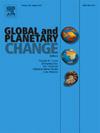根据黄土白云岩记录推断的中亚北部伊犁盆地末次冰川期降水量变化
IF 4
1区 地球科学
Q1 GEOGRAPHY, PHYSICAL
引用次数: 0
摘要
中亚是全球沙尘源,因此了解中亚的气候演变及其驱动因素对于做出明智决策和预测全球变化至关重要。遗憾的是,由于可靠的代用指标有限,我们目前对中亚地区全新世以前的降水模式缺乏了解,而且我们根据古气候动力学对该地区未来降水预测的了解也相当有限。在本研究中,我们分析了加利福尼亚州北部伊犁盆地黄土剖面碳酸盐岩和白云岩含量的变化,以揭示末次冰川期降水的变化。结果表明,碳酸盐矿物的变化主要受源物质供应的影响,冰川期降水减少和冲积作用是其主要驱动力。因此,我们从白云石记录中剔除了来源信号的影响,建立了降水指数。该指数表明,与 MIS2 相比,海洋同位素中期阶段(MIS)3 的降水量较低,这可能是由于前向和纬度变化引起的西风经向移动和强度变化造成的,其中前向起了主要作用。通过将降水指数与格陵兰冰芯的 δ18O 记录进行千年时间尺度的比较,观察到由于西风的迁移,加利福尼亚北部的降水与北大西洋涛动(NAO)模式呈正相关。通过对轨道和千年尺度降水模式的了解,我们利用随机森林回归模型和自回归综合移动平均模型预测了未来 5000-10,000 年的降水变化。结果表明,该地区降水格局多变,总体呈上升趋势,表明伊犁河谷以农业为基础的经济有可能得到良好发展。人们应该认识到,一些综合措施旨在提高该地区农业部门的抗灾能力,增强其适应气候变化挑战的能力。然而,有必要进行更广泛的研究,通过对我们研究地点的黄土剖面进行彻底检查和比较,来验证这些结果。本文章由计算机程序翻译,如有差异,请以英文原文为准。
Precipitation changes during the last glacial period in the Ili Basin, northern Central Asia, as inferred from the records of loess dolomite
Understanding the climatic evolution in Central Asia (CA) and its drivers is crucial for informed decision-making and predicting global changes due to its significant contribution as a global dust source. Unfortunately, our current understanding of the pre-Holocene precipitation patterns in CA is lacking due to the limited availability of reliable proxy indicators, and our knowledge of future precipitation projections in the region, based on paleoclimatic dynamics, is also quite limited. In this study, we analyzed variations in carbonate and dolomite contents of a loess section in the Ili Basin, northern CA, to reveal precipitation changes during the last glacial period. The results showed that changes in carbonate minerals were mainly influenced by the source material supply, driven by reduced precipitation and eluviation during glacial period. We thereby established a precipitation index by removing the influence of provenance signals from the dolomite records. The index indicated lower precipitation during mid-marine isotope stage (MIS) 3 compared to MIS2, likely due to meridional shifts and intensity changes of the westerlies caused by changes in precession and obliquity, with precession playing a major role. Through the comparison of the precipitation index with the δ18O records of the Greenland ice core on a millennial timescale, it was observed that the precipitation in northern CA exhibited a positive correlation with the North Atlantic Oscillation (NAO) mode due to migration of the westerlies. By leveraging our understanding of orbital- and millennial-scale precipitation patterns, we utilized the random forest (RF) regression model and the autoregressive integrated moving average model to forecast precipitation changes for the upcoming 5000–10,000 years. The results indicated a variable pattern marked by a general upward trend, suggesting the possibility of favorable development of agricultural-based economies in the Ili River Valley. People should realize that some integrated measures are designed to improve resilience of agricultural sector in the region and enhance its capacity to adapt to challenges posed by climate change. However, more extensive research is necessary to verify these results through thorough examination and comparisons of loess sections in our research location.
求助全文
通过发布文献求助,成功后即可免费获取论文全文。
去求助
来源期刊

Global and Planetary Change
地学天文-地球科学综合
CiteScore
7.40
自引率
10.30%
发文量
226
审稿时长
63 days
期刊介绍:
The objective of the journal Global and Planetary Change is to provide a multi-disciplinary overview of the processes taking place in the Earth System and involved in planetary change over time. The journal focuses on records of the past and current state of the earth system, and future scenarios , and their link to global environmental change. Regional or process-oriented studies are welcome if they discuss global implications. Topics include, but are not limited to, changes in the dynamics and composition of the atmosphere, oceans and cryosphere, as well as climate change, sea level variation, observations/modelling of Earth processes from deep to (near-)surface and their coupling, global ecology, biogeography and the resilience/thresholds in ecosystems.
Key criteria for the consideration of manuscripts are (a) the relevance for the global scientific community and/or (b) the wider implications for global scale problems, preferably combined with (c) having a significance beyond a single discipline. A clear focus on key processes associated with planetary scale change is strongly encouraged.
Manuscripts can be submitted as either research contributions or as a review article. Every effort should be made towards the presentation of research outcomes in an understandable way for a broad readership.
 求助内容:
求助内容: 应助结果提醒方式:
应助结果提醒方式:


